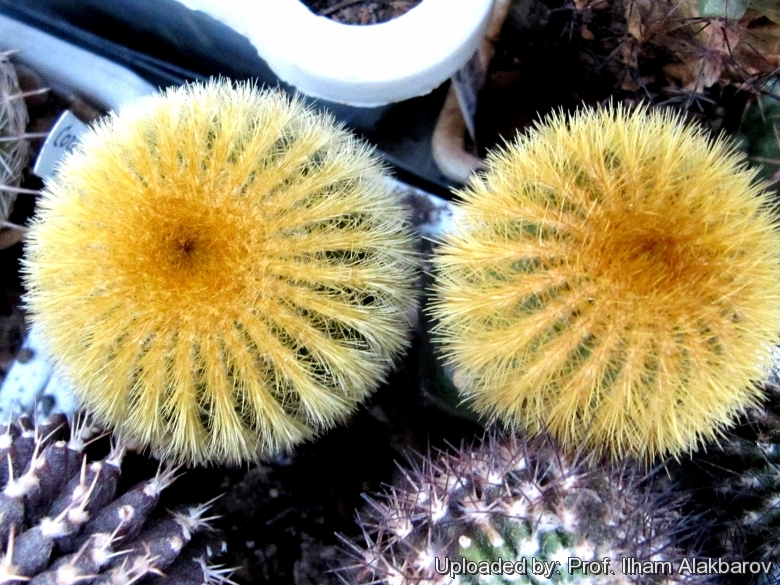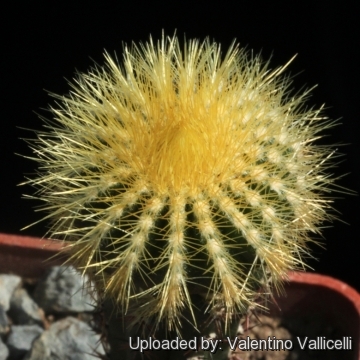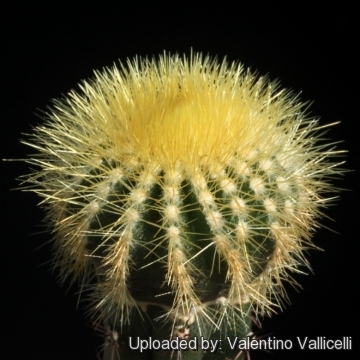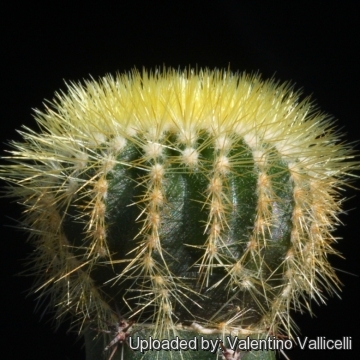
Uebelmannia pectinifera var. eriocactoides Photo by: Prof. Ilham Alakbarov
Origin and Habitat: Minas Gerais, Brazil, Southern America. (Apud urbem Diamantina, in rupibus quarciticis Serra do Espinhaço, ad occidentem a pago Inhaí versus, 1100m)
Altitude: 700-1100 m over sea level.
Habitat: They grow in a arid area on steep slopes, ridges, horizontal crevices, vertical quartzite rocks and hill sparsely covered by small, mostly deciduous, shrubs (caatinga formation). Associated cactus flora include Discocactus placentiformisSN|1430]]SN|1430]] var. pulvinicapitatus, Cipocereus bradeiSN|6850]]SN|6618]], Cipocereus crassisepalusSN|7832]]SN|7832]], Cipocereus minensisSN|6618]]SN|6850]], and Pilosocereus aurisetusSN|6546]]SN|6546]].
Synonyms:
See all synonyms of Uebelmannia pectinifera
Description: The seedlings of Uebelmannia pectiniferaSN|14312]]SN|14312]] var. eriocactoides closely resemble to juvenile plants of Eriocactus leninghausii, hence the name. This taxon differs from the related taxa of the Uebelmannia pectiniferaSN|14312]]SN|14312]] complex also for it tall upright habit
Stem: Clavate to shortly columnar, 30-50(-80) cm tall. At maturity, the stems become spineless at the base and have a white or bluish patina on the skin near the top. The stem appears almost completely covered with conspicuous, young, golden-yellow spines. Apex usually not woolly. The newly growing stem apex is light green, soon covered by a coating.
Ribs: 18-25 straight.
Areoles: Closely set, located individually on the ribs and not joined into a single line.
Spines: The spines in juvenile plants up to 5-8 cm in diameter are 11-20 per areole very dense golden-yellow to whitish-yellow, about 10 mm long and resemble to those of the genus Eriocactus thy are short, fine needle-like, pointing diagonally and horizontally often curved downwards, but as the plant ages the spines decrease in number, become longer, straight and almost pectinately arranged, up to 40mm long, turn greyish and easily fall off from old areoles. New yellow brown spines contrast nicely with older spines, which are grey.
Flowers: Diurnal, funnel-shaped greenish yellow. They are 15 mm long, 12 mm in diameter.
Blooming season: Flowers come sporadically from Early spring to Late Summer
Remarks: The variability range within var. eriocactoides is very limited: plants are almost uniform.
Subspecies, varieties, forms and cultivars of plants belonging to the Uebelmannia pectinifera complex
 Uebelmannia pectinifera Buining: (ssp. pectinifera) It has about 18 ribs and slowly grow up to 50 cm in height. Origin: It comes from the mountains in the higher part of the areal.
Uebelmannia pectinifera Buining: (ssp. pectinifera) It has about 18 ribs and slowly grow up to 50 cm in height. Origin: It comes from the mountains in the higher part of the areal. Uebelmannia pectinifera var. crebispina n.n.: Barao de Quacuy, Minas Gerais, Brazil.
Uebelmannia pectinifera var. crebispina n.n.: Barao de Quacuy, Minas Gerais, Brazil. Uebelmannia pectinifera var. eriocactoides Řepka, Krajča & V.Toman: The seedlings closely resemble to juvenile plants of Eriocactus leninghausii, hence the name.
Uebelmannia pectinifera var. eriocactoides Řepka, Krajča & V.Toman: The seedlings closely resemble to juvenile plants of Eriocactus leninghausii, hence the name. Uebelmannia pectinifera subs. flavispina (Buining & Bredero) P.J.Braun & Esteves: It has up to 29 ribs with amber yellow spines, and can grow about 35 cm tall. Origin: west of Diamantina.
Uebelmannia pectinifera subs. flavispina (Buining & Bredero) P.J.Braun & Esteves: It has up to 29 ribs with amber yellow spines, and can grow about 35 cm tall. Origin: west of Diamantina. Uebelmannia pectinifera subs. flavispina var. longispina n.n.: like subsp. flavispina, but spines longer and thicker. Distribution: Guinda, Minas Gerais, Brazil.
Uebelmannia pectinifera subs. flavispina var. longispina n.n.: like subsp. flavispina, but spines longer and thicker. Distribution: Guinda, Minas Gerais, Brazil. Uebelmannia pectinifera subs. horrida (P.J.Braun) P.J.Braun & Esteves: Stem with more than 23 ribs (up to 40) it is the taller of the three and can reach 1 m of height. Origin: Serra do Espihaço.
Uebelmannia pectinifera subs. horrida (P.J.Braun) P.J.Braun & Esteves: Stem with more than 23 ribs (up to 40) it is the taller of the three and can reach 1 m of height. Origin: Serra do Espihaço. Uebelmannia pectinifera var. multicostata Buining & Bredero: has 20 or more ribs. Distribution: 10 km E of Mendanha towards the Rio Jequitinhonha, Minas Gerais, Brazil.
Uebelmannia pectinifera var. multicostata Buining & Bredero: has 20 or more ribs. Distribution: 10 km E of Mendanha towards the Rio Jequitinhonha, Minas Gerais, Brazil. Uebelmannia pectinifera var. pseudopectinifera Buining: has smaller and greener stems, with separate (not confluent) areoles without brush-like spines. Distribution: Diamantina, Minas Gerais, Brazil.
Uebelmannia pectinifera var. pseudopectinifera Buining: has smaller and greener stems, with separate (not confluent) areoles without brush-like spines. Distribution: Diamantina, Minas Gerais, Brazil. Uebelmannia pectinifera f. variegata hort.
Uebelmannia pectinifera f. variegata hort.
Bibliography: Major references and further lectures
1) Edward Anderson “The Cactus family” Timber Press, Incorporated, 2001
2) James Cullen, Sabina G. Knees, H. Suzanne Cubey "The European Garden Flora Flowering Plants: A Manual for the Identification of Plants Cultivated in Europe, Both Out-of-Doors and Under Glass" Cambridge University Press, 11/Aug/2011
3) David R Hunt; Nigel P Taylor; Graham Charles; International Cactaceae Systematics Group. "The New Cactus Lexicon" dh books, 2006
4) Machado, M., Taylor, N.P. & Braun, P. 2013. Uebelmannia pectinifera. In: IUCN 2013. "IUCN Red List of Threatened Species." Version 2013.2. <www.iucnredlist.org>. Downloaded on 08 January 2014.
5) Rudy Krajča - The Cactus Explorer 3: 54-57 2012 [3 February 2012]
 Uebelmannia pectinifera var. eriocactoides Photo by: Prof. Ilham Alakbarov
Uebelmannia pectinifera var. eriocactoides Photo by: Prof. Ilham Alakbarov Uebelmannia pectinifera var. eriocactoides Photo by: Valentino Vallicelli
Uebelmannia pectinifera var. eriocactoides Photo by: Valentino Vallicelli Uebelmannia pectinifera var. eriocactoides Photo by: Valentino Vallicelli
Uebelmannia pectinifera var. eriocactoides Photo by: Valentino Vallicelli Uebelmannia pectinifera var. eriocactoides Photo by: Valentino Vallicelli
Uebelmannia pectinifera var. eriocactoides Photo by: Valentino VallicelliCultivation and Propagation: This tropical cactus loves warm moist, humid conditions and mist spraying is a must in summer. Water regularly during the growing season and use a very draining mineral potting substrate. At the onset of winter, do not water. Uebelmannias need heat all year round and extra winter heat, minimum 10° C is best. Avoid any frost. Keep cool in summer. This plant prove to be root prone if kept too cold in winter. To help stop this, a good deep collar of pumice or lava grit is an excellent idea. It prefers a position in full sun, and possibly afternoon shade in summer. If you can place it so that this occurs, the plant will be much happier.
Propagation: Seeds, but plants are often grafted, making them easier to grow, particularly through the winter. If possible using a rootstock that is more hardy than the Uebelmannia is ideal.














